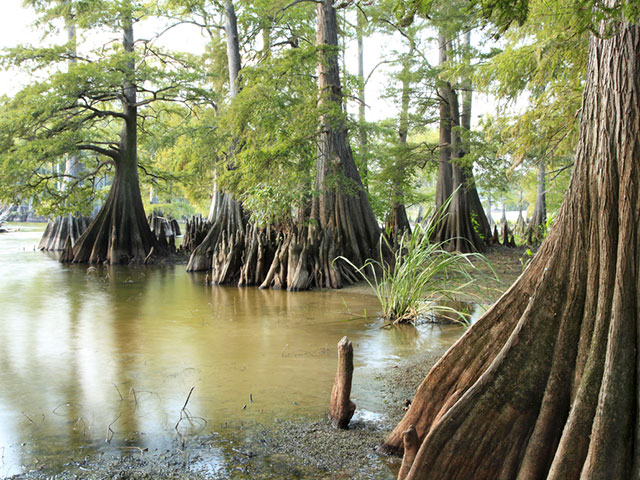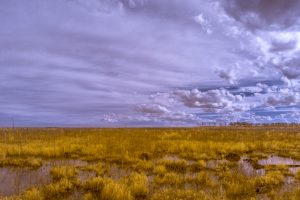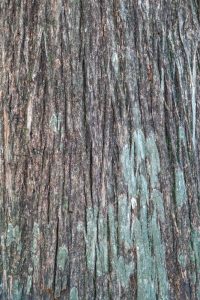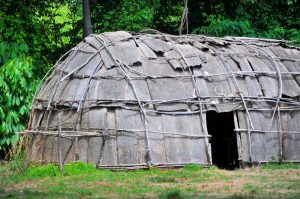
Materials of Sleep: Cypress Bark
Our first blog ‘mini-series’ explores the uses of specific materials for sleeping well. In this first post, Dr Holly Fletcher reveals the importance of cypress bark for native communities and colonists in early America.
 In March 1728 a team of surveyors set out into the Great Dismal Swamp of southern Virginia and northern North Carolina, on a mission to chart the dividing line between the two states which cut across the area of swampland. They took on their backs both their provisions and bedding, as they expected to stay in the swamp for up to eight days. On entering the swamp, however, they found it to be a somewhat inhospitable environment and they soon began to be ‘troubled with fluxes, occasioned by bad water and moist lodging’. This account was recorded by the American planter, lawyer and author William Byrd II who led the expedition and later published his observations on its progress.
In March 1728 a team of surveyors set out into the Great Dismal Swamp of southern Virginia and northern North Carolina, on a mission to chart the dividing line between the two states which cut across the area of swampland. They took on their backs both their provisions and bedding, as they expected to stay in the swamp for up to eight days. On entering the swamp, however, they found it to be a somewhat inhospitable environment and they soon began to be ‘troubled with fluxes, occasioned by bad water and moist lodging’. This account was recorded by the American planter, lawyer and author William Byrd II who led the expedition and later published his observations on its progress.
Damp sleeping conditions were understood to be particularly unhealthy in the early modern period as they were thought to cause fluxes and distempers in the body, meaning an imbalance of the four humours of Galenic medicine (blood, phlegm, yellow bile and black bile) or of the bodily fluids more generally. Among colonists in early America, this meant there were repeated warnings about the changeability of the climate, for instance, in which one might go to bed sweating because of the heat and then wake up cold and damp in the middle of the night.1 To ensure a good night’s sleep, bedding textiles and materials that had good absorbency were highly prized, and people worked hard to regulate the temperature and freshness of the air within the bedchamber.2
 Avoiding dampness in the boggy landscape of the Great Dismal Swamp was an especially difficult task. The surveyors faced the challenge of creating a healthy sleeping environment while setting up camp on ground that was continually wet and marshy. To do so, Byrd tells us, ‘They first covered the ground with square pieces of cypress bark, which now, in the spring, they could easily slip off the tree for that purpose. On this they spread their bedding.’ The surveyors thus looked to the environment around them, using the bark from cypress trees to try and keep dry. These trees were most likely bald cypress trees (Taxodium distichum) also known as swamp cypress, the most common type of cypress tree found in the Great Dismal Swamp. These are identifiable by their ‘knees’ which are thought to supply air to the roots when they are immersed in water and allow them to thrive in damp conditions.3 The timber of the swamp cypress is known to be very resistant to water, and mulch made from its wood and bark is used to repel insects such as termites, cockroaches and ants.4 Wanting to keep their bedding dry and pest-free, the surveyors may have used some knowledge of the properties of these trees in making their choice of ground-covering.
Avoiding dampness in the boggy landscape of the Great Dismal Swamp was an especially difficult task. The surveyors faced the challenge of creating a healthy sleeping environment while setting up camp on ground that was continually wet and marshy. To do so, Byrd tells us, ‘They first covered the ground with square pieces of cypress bark, which now, in the spring, they could easily slip off the tree for that purpose. On this they spread their bedding.’ The surveyors thus looked to the environment around them, using the bark from cypress trees to try and keep dry. These trees were most likely bald cypress trees (Taxodium distichum) also known as swamp cypress, the most common type of cypress tree found in the Great Dismal Swamp. These are identifiable by their ‘knees’ which are thought to supply air to the roots when they are immersed in water and allow them to thrive in damp conditions.3 The timber of the swamp cypress is known to be very resistant to water, and mulch made from its wood and bark is used to repel insects such as termites, cockroaches and ants.4 Wanting to keep their bedding dry and pest-free, the surveyors may have used some knowledge of the properties of these trees in making their choice of ground-covering.
It was frequently reported that indigenous communities in Virginia and North Carolina used bark, and specifically cypress bark, to protect their own lodgings from the weather. In his natural history of North Carolina from 1737, for instance, Irish-born John Brickell wrote that indigenous people would create circular wooden structures, and would ‘cover them all over with Barks of Trees (except a hole to let out the Smoak) that they are warm and tight and will keep firm against wind and weather’. He stated ‘The Bark they generally make their Cabbins with is Cypress, or red or white Cedar, sometimes when they are a great way distance from any of these Woods, they make use of the Pine bark, which is the worst sort to cover their Houses with’. Brickell was clearly aware that the properties of cypress bark made it a better ‘sort’ of wood than pine at keeping out the elements.
 In Byrd’s account of the expedition, he similarly wrote of Nottoway town, an indigenous settlement, where cabins were ‘covered so well with bark as to be proof against all weather’. It seems possible that Byrd’s surveyors drew on an awareness of the use of bark, and specifically cypress bark, by local indigenous communities as they attempted to keep the dampness of the Swamp out of their bedding. Using the bark in this way, Byrd stated ‘made their Lodging hard, but much more wholesome’. Unfortunately, however, he also recorded the failure of their use of this material. He described how ‘unhappily the weight and warmth of their bodies made the water rise up betwixt the joints of the bark to their great inconvenience. Thus they lay not only moist, but also exceedingly cold, because their fires were continually going out.’
In Byrd’s account of the expedition, he similarly wrote of Nottoway town, an indigenous settlement, where cabins were ‘covered so well with bark as to be proof against all weather’. It seems possible that Byrd’s surveyors drew on an awareness of the use of bark, and specifically cypress bark, by local indigenous communities as they attempted to keep the dampness of the Swamp out of their bedding. Using the bark in this way, Byrd stated ‘made their Lodging hard, but much more wholesome’. Unfortunately, however, he also recorded the failure of their use of this material. He described how ‘unhappily the weight and warmth of their bodies made the water rise up betwixt the joints of the bark to their great inconvenience. Thus they lay not only moist, but also exceedingly cold, because their fires were continually going out.’
From the surveyors’ use of cypress bark in the Great Dismal Swamp we see how early modern people could interact with their material environments in an attempt to create healthy sleeping conditions, in this case in exceptional circumstances. The surveyors both utilised the materials that were available to them and drew on their existing knowledge of the use and properties of cypress bark to prevent the sickness and disrupted sleep that were threatened by the damp and cold conditions of the swamp.
1 Karen Ordahl Kupperman, ‘Fear of Hot Climates in the Anglo-American Colonial Experience’, The William and Mary Quarterly, 41 (1984), pp. 213-240, here p. 225.
2 On the use of absorbent materials see Sasha Handley, Sleep in Early Modern England, (New Haven: Yale University Press, 2016) pp. 49-50 & 58-60. This includes a discussion of an extant mattress made of plaited carex or sedge found at Titchfield, Hampshire (p. 58). The absorbency of this straw-like material would have been central to its use underneath bedding textiles. Archaeological research has shown that grass and wood have been used as bedding, likely for similar purposes, from as early as 227,000 years ago. See Michael Le Page, ‘Earliest known beds are 227,000 year-old piles of grass and ash’, New Scientist, August 2020. https://www.newscientist.com/article/2251738-earliest-known-beds-are-227000-year-old-piles-of-grass-and-ash/
3 George K. Rogers, ‘Bald Cypress knees, Taxodium distichum (Cupressaceae): An Anatomical
Study, with Functional Implications’, Flora 278 (2021), p. 2
4 ‘Bald Cypress’, Encyclopaedia Britannica, 20 November 2017. https://www.britannica.com/plant/bald-cypress-species. On cypress mulch’s insect-repelling qualities see: Gondhalekar et al, ‘A Review of Alternative Management Tactics Employed for the Control of Various Cockroach Species in the USA’, Insects 12 (2021), p. 12. Scheffrahn et al, ‘Allelochemical resistance of bald cypress, Taxodium distichum, heartwood to the subterranean termite’, Coptotermes formosanus, Journal of Chemical Ecology, 14 (1988), pp. 765-775.








0 Comments